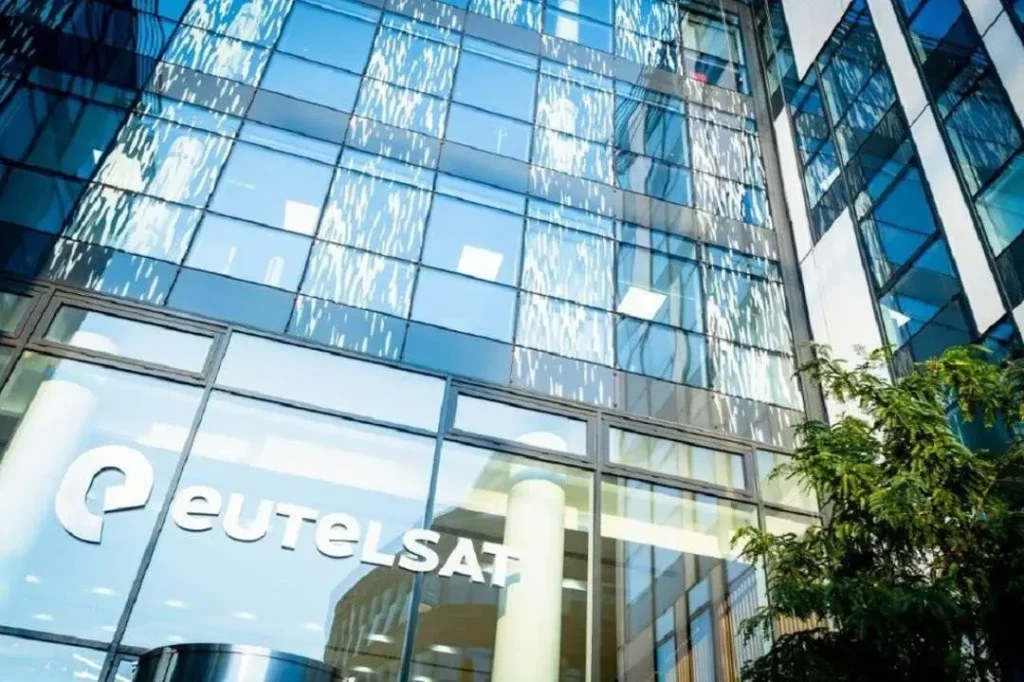Eutelsat is rapidly emerging as a pivotal player in the race for European satellite internet, positioning itself as a formidable competitor to Starlink, Elon Musk’s satellite broadband giant. Last week, Eutelsat secured over 1 billion euros in investment, predominantly from the French government, highlighting its importance for Europe’s technological sovereignty ambitions. This investment, marking a significant milestone, is aimed at enhancing Eutelsat’s capabilities in the satellite communications sector, especially as it combines forces with OneWeb. However, many experts remain skeptical about whether Eutelsat can realistically match the scale and infrastructure of Starlink, which boasts an impressive constellation of over 7,600 Low Earth Orbit (LEO) satellites. The future of Eutelsat as a key player in this competitive landscape hinges on its ability to leverage investments effectively and expand its LEO satellite network to challenge its American rival head-on.
Eutelsat, a French satellite operator, is positioning itself as Europe’s potential alternative to SpaceX’s Starlink in the growing satellite internet market. With a recent influx of over 1 billion euros from the French state, Eutelsat aims to strengthen its foothold in this crucial technological arena. The company, through its merger with OneWeb, is focused on developing its constellation of satellites to offer competitive services, particularly in the realm of European satellite internet. However, analysts highlight substantial challenges in scaling its operations and expanding its fleet of LEO satellites to keep pace with Starlink’s vast network. As the ambition to establish a sovereign satellite internet presence grows, Eutelsat’s developments will be critical in shaping the future broadband landscape across Europe.
Eutelsat: Europe’s Satellite Internet Challenger
Eutelsat has been positioned as Europe’s counterweight to Elon Musk’s Starlink, particularly in light of recent significant investments, including over 1 billion euros from the French state. This substantial backing underscores France’s ambition to establish Eutelsat as a strategic asset that enhances the European Union’s technological sovereignty. The merger in 2023 with OneWeb, a British satellite venture, allows Eutelsat to consolidate its resources and capabilities, aiming to present a formidable alternative to Starlink’s expansive network of satellites.
Despite these efforts, skepticism remains concerning Eutelsat’s ability to compete directly with Starlink. Analysts emphasize that Eutelsat will need to scale up significantly in terms of Low Earth Orbit (LEO) satellites to offer competitive speed and coverage. Current estimates suggest Eutelsat’s fleet operates around 650 LEO satellites, a fraction of the thousands of operational satellites under Starlink’s ownership, which poses serious challenges in catching up to the U.S. satellite internet giant.
The Strategic Importance of Eutelsat’s Investments
France’s significant investment in Eutelsat is also seen as part of a broader strategy to promote European independence in satellite communications. This investment aims to fortify Eutelsat as a dual-use infrastructure provider, catering not only to commercial markets but also to critical national security needs. As Eutelsat enhances its offerings, the European Union hopes to mitigate reliance on U.S. technologies, which have dominated the market largely through SpaceX’s Starlink.
Furthermore, discussions surrounding Eutelsat’s role emphasize its strategic priority in strengthening Europe’s defense capabilities. As nations within the EU recognize the importance of secure communication lines in today’s geopolitical climate, Eutelsat’s development of its satellite services could be a vital component of Europe’s long-term strategy in the global space race.
Investment Challenges in the Satellite Market
While the latest funding marks a pivotal moment for Eutelsat, the satellite market operates on a scale where capital investment typically translates into capability. Experts warn that despite the recent cash infusion, Eutelsat still faces monumental challenges in overcoming the vast lead held by Starlink in terms of both satellite quantity and technological advancement. Eutelsat needs to navigate significant hurdles in increasing its satellite capacity to even begin to match the robust network created by SpaceX.
Additionally, the operational lifespan of existing satellites within Eutelsat’s fleet raises concern. As many of OneWeb’s satellites approach end-of-life stages, Eutelsat must focus on replacing these units while simultaneously expanding its constellation. This dual obligation of replacing aging satellites and building new ones demands a multifaceted approach to investment that goes beyond immediate financial support.
Eutelsat’s OneWeb and Its Future Prospects
The merger with OneWeb provides Eutelsat with a critical operational backbone, as the combined entity aims to enhance broadband access across Europe and beyond. However, the current bent-pipe architecture of OneWeb’s satellites is less sophisticated compared to Starlink’s technology. The need for updated satellite designs within the OneWeb system presents additional complexity as Eutelsat strives to operate a competitive service.
Looking forward, Eutelsat must navigate a strategic landscape that calls for innovative approaches to satellite design and deployment. Developing second-generation satellites that incorporate advancements comparable to Starlink will be essential for ensuring Eutelsat can effectively compete in the burgeoning market for satellite internet services. Failure to adapt its satellite network could result in continued lagging behind Starlink, especially as demand for high-speed internet services escalates globally.
Market Context of European Satellite Providers
In the broader context of the European satellite telecommunications market, the emergence of Eutelsat represents a crucial step toward reducing reliance on U.S.-based providers. However, competition not only stems from Starlink but also from other emerging enterprises in the satellite sector. Eutelsat’s potential competition with other European entities hinges on its ability to optimize its market strategies and solidify its advantage in regions where sovereignty and security are paramount.
The push for European companies to invest in local satellite alternatives signals a shift toward prioritizing regional players in telecommunications infrastructure. Eutelsat’s focus on providing secure and reliable satellite internet services could find traction among enterprises and governmental bodies looking for stable, jurisdictionally compliant options. Such developments may ultimately pave the way for a more competitive satellite market in Europe.
Eutelsat in the Context of Geopolitical Trends
The geopolitical landscape significantly influences the trajectory of satellite internet services, where the demands for security and reliability converge. Eutelsat’s designation as a critical asset in France’s strategy reflects broader concerns about technological dependencies and vulnerabilities. As Europe sets its sights on technological sovereignty, the role of Eutelsat becomes increasingly important for safeguarding communications and providing robust internet services in sensitive contexts.
The ongoing developments in Ukraine have amplified this notion, as Eutelsat is viewed as a potential alternative to Starlink. With Germany deploying Eutelsat terminals in a bid to diversify satellite internet options for the Ukrainian military, the scenario underscores Eutelsat’s potential role in safeguarding essential services. Such strategic deployments may reinforce Eutelsat’s positioning as a reliable service provider in regions requiring secure communication channels.
Eutelsat’s Unique Offerings Compared to Starlink
Eutelsat’s operational model differs significantly from Starlink’s, particularly with its deployment of both geostationary (GEO) and Low Earth Orbit (LEO) satellites. This mixed architecture allows Eutelsat to cater to specialized needs such as remote area coverage while also expanding broadband services. They can provide targeted solutions for specific use cases, which could differentiate their offerings in the competitive satellite market.
In contrast, Starlink’s singular focus on LEO satellites allows for rapid deployment and expansive coverage, making it a top choice for mass-market scenarios. However, Eutelsat’s diversity in satellite services could appeal to enterprise and governmental clients looking for customized solutions that emphasize control and security. As these needs grow, Eutelsat may capitalize on becoming a key player in segments that prioritize these attributes.
The Future of Satellite Internet in Europe
As the demand for satellite broadband continues to grow, the future of Eutelsat will largely depend on its ability to innovate and expand. Without a robust constellation of satellites capable of competing with the likes of Starlink, Eutelsat risks falling behind in capturing market share. Yet, investments such as the recent backing by France illustrate that stakeholders are still investing in belief that Eutelsat can fulfill critical needs within Europe.
The overall trajectory of the satellite internet sector will hinge on the pace of technological advancements and Eutelsat’s responsiveness to market demands. As more players enter this competitive arena, those that can pivot quickly and leverage their unique offerings will likely succeed. Therefore, Eutelsat’s strategic decisions in the coming years will be pivotal as it seeks to assert itself as a leader in Europe’s satellite communications.
Eutelsat’s Role in Securing European Interests
Eutelsat’s aspirations to bolster European interests come amid escalating global tensions and the push for enhanced sovereign capabilities in technology. By positioning itself as a reliable service provider, Eutelsat aims to support not only commercial activities but also national security mandates. This dual-purpose mission is critical as European nations increasingly recognize the importance of independent capabilities in the digital realm.
The simultaneous challenges posed by rivals like Starlink and the need for sustained investment in satellite technologies underline the complexity of Eutelsat’s position. To genuinely function as a strategic asset for Europe, Eutelsat must navigate the interplay of market demands, technological evolution, and the overarching goal of ensuring European autonomy in essential communications.
Frequently Asked Questions
What is Eutelsat’s role as a competitor to Starlink in Europe?
Eutelsat aims to be Europe’s answer to Starlink by providing satellite internet services. The French state recently backed Eutelsat with significant investment, reinforcing its status as a strategic asset for the EU’s technological sovereignty. However, experts warn that Eutelsat’s current capabilities lag behind Starlink, particularly regarding the number of Low Earth Orbit (LEO) satellites.
How does Eutelsat OneWeb compare to Starlink in terms of satellite capacity?
Eutelsat OneWeb operates around 650 LEO satellites, which is significantly less than Starlink’s over 7,600 satellites. This disparity in satellite constellation size presents a major challenge for Eutelsat in achieving comparable coverage and capacity to its main competitor, Starlink.
What investments have been made in Eutelsat to enhance its satellite capabilities?
Recently, the French government led a €1.35 billion investment in Eutelsat, making it the largest shareholder. This funding is expected to help Eutelsat enhance its infrastructure and capability, allowing it to work towards becoming a viable competitor to Starlink in the satellite internet market.
Can Eutelsat effectively serve markets like Ukraine where Starlink has been dominant?
While Eutelsat has begun operating in Ukraine by deploying terminals, it cannot currently match the scale and capacity of Starlink, which has deployed around 50,000 terminals for military use. Eutelsat’s efforts can provide an alternative, but it may not fully replace Starlink’s extensive services.
What strategic advantages does Eutelsat have in the European market?
Eutelsat’s strategic advantages include its focus on providing sovereign satellite communication services tailored for enterprise clients and security-sensitive operations. Additionally, its recent merger with OneWeb positions it to leverage a more significant European presence in satellite internet services, contrasting with the U.S.-dominated field.
How does Eutelsat plan to differentiate itself from Starlink going forward?
Eutelsat plans to differentiate by developing a unique go-to-market model that capitalizes on its operational improvements and strong European ties. It emphasizes its dual-use capabilities for critical infrastructure, unlike Starlink’s commercial focus, aiming primarily at security and jurisdictional control.
What challenges does Eutelsat face in competing with Starlink?
Eutelsat faces several critical challenges, including the need for greater investment in LEO satellites, technological disparities between its satellites and Starlink’s, limited launch capabilities, and overall lower capital reserves compared to SpaceX. These factors could hinder Eutelsat’s ability to compete effectively in the satellite broadband market.
What makes Eutelsat a strategic asset for Europe?
Eutelsat is considered a strategic asset for Europe due to its potential to enhance the EU’s technological sovereignty in satellite communications. France’s investment highlights the importance of having a European alternative to U.S. satellite services, ensuring that Europe maintains control over critical communication infrastructures.
How does Eutelsat’s satellite architecture differ from Starlink’s?
Eutelsat utilizes a combination of geostationary (GEO) and LEO satellites, which serve different purposes compared to Starlink’s sole focus on LEO satellites. The architectural differences impact service delivery; for example, Eutelsat’s GEO satellites can provide broader coverage for specialized applications, while Starlink’s LEO satellites offer low-latency internet for mass-market consumption.
What advancements are needed for Eutelsat to close the gap with Starlink?
To close the gap with Starlink, Eutelsat needs to significantly increase its number of operational LEO satellites, improve manufacturing throughput, diversify its launch access, and enhance its technical capabilities to match Starlink’s system performance. Continued strategic investments and innovation will also be vital for Eutelsat’s future growth.
| Key Point | Details |
|---|---|
| Investment in Eutelsat | France led a 1.35 billion euro investment, making it the biggest shareholder with a 30% stake. |
| Eutelsat’s Status | Eutelsat is seen as a strategic asset for the EU’s push for technological sovereignty but is still far behind Starlink in market cap and satellite constellation. |
| Size Comparison | Starlink operates over 7,600 satellites, while Eutelsat’s OneWeb has 650, requiring significant scale-up to compete. |
| Future Challenges | Eutelsat must overcome its current limitations in financing, manufacturing, launch access, and technology to rival Starlink. |
| Eutelsat’s Focus Areas | The company is well-positioned for European sovereign, security-sensitive, and enterprise segments that prioritize jurisdictional control. |
| Differentiation | Eutelsat operates both GEO and LEO satellites, focusing on specialized use cases, while Starlink primarily targets mass market. |
Summary
Eutelsat is positioned as Europe’s hopeful successor to Starlink, receiving significant backing from France in a bid to enhance its capabilities for a technologically sovereign Europe. This investment highlights the strategic importance of Eutelsat in the growing satellite communications landscape, despite experts expressing skepticism about its ability to compete on the same scale as Starlink. The future of Eutelsat relies on its capacity to overcome existing challenges and solidify its role within the European market, focusing on specialized and enterprise applications.



